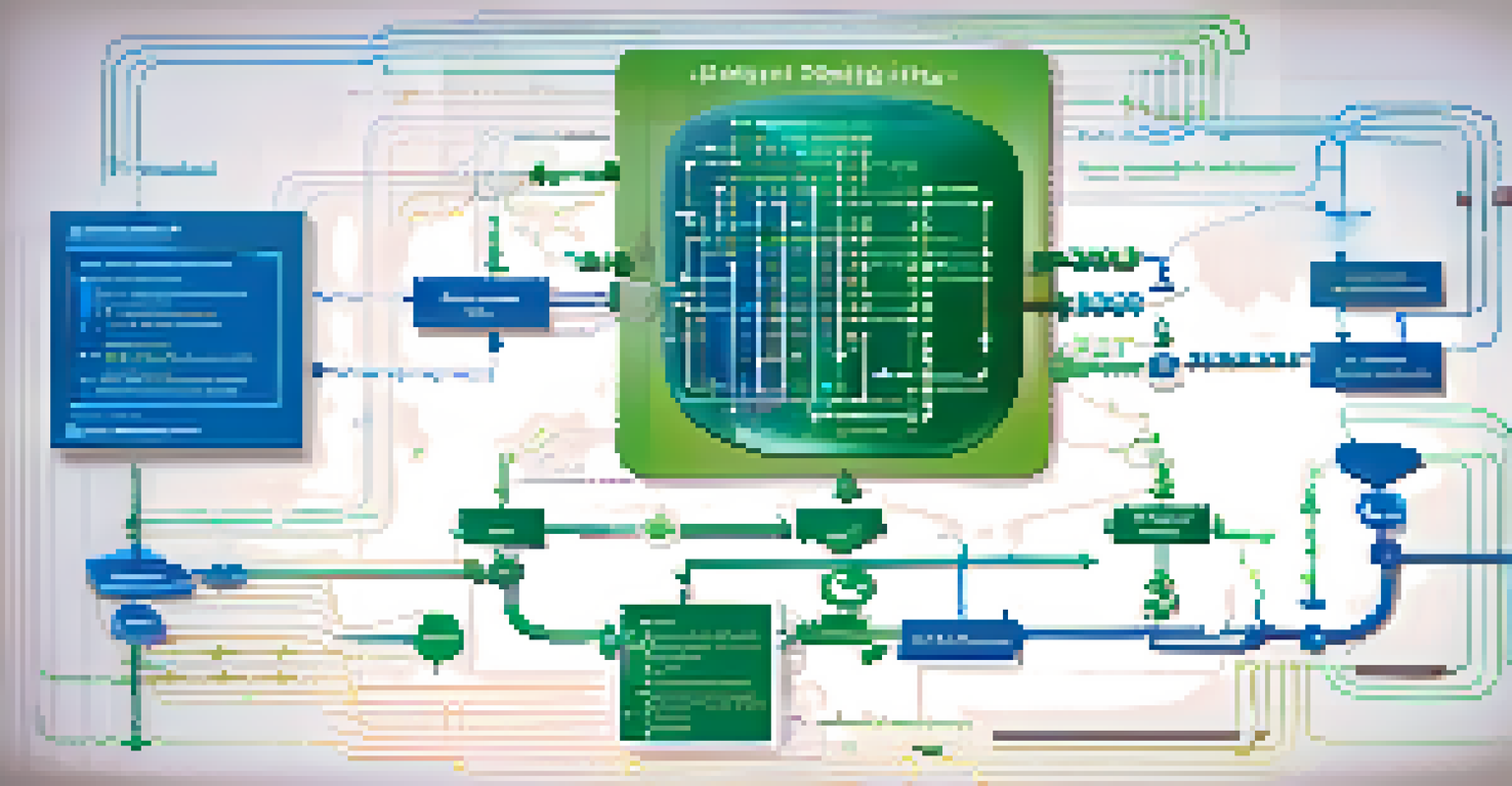The Role of Continuous Testing in Software Development Life Cycle

Understanding Continuous Testing in Software Development
Continuous testing is an integral part of the software development life cycle (SDLC) that focuses on validating software at every stage. This approach ensures that any defects are caught early, reducing the cost and time associated with fixing them later. By continuously testing, teams can gain immediate feedback on their code, promoting a culture of quality and responsiveness.
Quality is never an accident; it is always the result of intelligent effort.
Think of continuous testing like regular check-ups at the doctor; just as early detection can prevent bigger health issues, continuous testing helps catch software bugs before they escalate. This proactive methodology shifts the focus from merely finding bugs at the end of the development process to consistently improving the product throughout its life cycle. It’s a game changer for teams looking to deliver high-quality software quickly.
Incorporating continuous testing helps foster a collaborative environment where developers, testers, and operations teams work closely together. This synergy not only improves communication but also enhances the overall quality of the software product. As a result, organizations can respond more effectively to market changes and user needs.
The Benefits of Continuous Testing in Agile Development
In Agile development, where iterations are rapid and frequent, continuous testing is invaluable. It allows teams to validate changes as they go, ensuring each iteration meets the desired quality standards. This approach minimizes the risk of deploying flawed software, which can lead to user dissatisfaction and costly fixes.

For example, imagine a team that releases new features every two weeks. With continuous testing, they can run automated tests after each code change, catching bugs before they make it to production. This not only speeds up the development process but also instills confidence in the team, knowing they can deliver high-quality features consistently.
Continuous Testing Boosts Quality
By validating software throughout its development life cycle, continuous testing helps catch defects early, reducing costs and enhancing product quality.
Moreover, continuous testing aligns perfectly with the principles of Agile, emphasizing collaboration and responsiveness. By integrating testing into the development process, teams can adapt quickly to feedback and changes, ultimately leading to better software that meets user expectations.
Key Tools for Implementing Continuous Testing
To effectively implement continuous testing, teams rely on various tools that automate the testing process. Popular tools like Selenium, JUnit, and TestNG help streamline testing efforts, allowing developers to focus more on coding rather than manual testing. These tools enable teams to run tests continuously, ensuring every code change is verified.
The greatest danger in times of turbulence is not the turbulence; it is to act with yesterday's logic.
For instance, a team using Selenium can automate their web application testing across different browsers and devices, which saves time and reduces human error. Such automation ensures that the application behaves as expected, regardless of the environment, which is crucial in today’s diverse tech landscape.
Additionally, integrating tools like Jenkins or CircleCI can help with continuous integration and continuous delivery (CI/CD) pipelines. These tools help orchestrate the entire testing process, triggering tests automatically when new code is pushed, thereby maintaining a high quality standard throughout the development cycle.
Challenges of Continuous Testing and Solutions
While continuous testing offers numerous benefits, it also presents challenges that teams must navigate. One significant hurdle is the initial investment in automation tools and setting up a robust testing environment. However, this upfront cost can lead to substantial long-term savings by reducing manual testing efforts and accelerating the release process.
Another challenge is maintaining the tests as the application evolves. As new features are added or existing ones are modified, tests must be updated to reflect those changes. Teams can tackle this by adopting a test-driven development (TDD) approach, which encourages writing tests before the actual code, ensuring that tests remain relevant and up-to-date.
Key Tools Streamline Automation
Using tools like Selenium and Jenkins, teams can automate testing processes, ensuring code changes are consistently verified and improving overall efficiency.
Lastly, teams may struggle with the cultural shift required for continuous testing. Transitioning from traditional testing methods to a culture that embraces continuous testing can be daunting. Continuous training and fostering open communication among team members can help ease this transition, promoting a shared commitment to quality.
The Impact of Continuous Testing on DevOps Practices
Continuous testing plays a pivotal role in enhancing DevOps practices, bridging the gap between development and operations. By integrating testing throughout the software development and deployment process, teams can ensure that their applications are not just functional but also stable and reliable. This alignment promotes a smoother workflow and faster delivery times.
Consider the analogy of a relay race; each runner must pass the baton smoothly for the team to succeed. In DevOps, continuous testing ensures that the 'baton'—the software—transfers seamlessly from development to operations. This reduces downtime and improves overall efficiency, enabling teams to deliver updates and new features rapidly.
Furthermore, continuous testing fosters a culture of accountability, as everyone in the team shares the responsibility for quality. Developers, testers, and operations personnel collaborate closely, leading to better communication and a unified approach to problem-solving. This holistic view ultimately supports the organization's goal of delivering excellent software to users.
Best Practices for Continuous Testing Implementation
To maximize the benefits of continuous testing, organizations should adopt best practices that align with their development goals. First and foremost, establishing a clear testing strategy that defines what to test, how to test, and when to test is crucial. This strategic approach ensures that testing efforts are targeted and effective, providing the most value.
Additionally, organizations should prioritize test automation while balancing it with manual testing where necessary. Not every test can or should be automated; human insight is invaluable for exploratory testing and understanding user experience. By identifying the right balance, teams can streamline their processes without sacrificing quality.
Cultural Shift is Essential
Successfully implementing continuous testing requires a cultural transition within teams, promoting collaboration and ongoing communication to maintain quality standards.
Finally, fostering a culture of continuous learning is essential for the success of continuous testing. Encouraging team members to share insights, lessons learned, and best practices can help improve testing strategies over time. Regular retrospectives can also be valuable, allowing teams to reflect on their testing processes and make necessary adjustments.
The Future of Continuous Testing in Software Development
As technology continues to evolve, the role of continuous testing in software development will only become more critical. With the rise of artificial intelligence and machine learning, we can expect testing tools to become smarter, identifying bugs and vulnerabilities with greater precision. This advancement will enhance the speed and effectiveness of testing efforts.
Moreover, the increasing adoption of microservices architecture will necessitate more robust continuous testing strategies. As applications become more complex and fragmented, ensuring the quality of individual services while maintaining overall system integrity will be paramount. Continuous testing will be essential in managing this complexity and ensuring seamless integration of services.

Finally, as organizations strive for faster releases and improved customer experiences, continuous testing will remain a cornerstone of agile and DevOps practices. The focus will be on not just speeding up development but also enhancing quality, ensuring that users receive reliable and high-performing software.